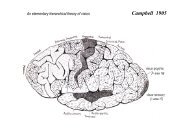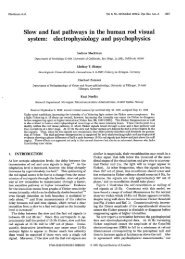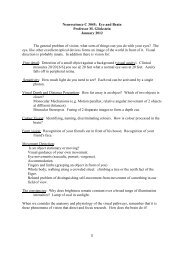Long-wavelength adaptation reveals slow ... - Journal of Vision
Long-wavelength adaptation reveals slow ... - Journal of Vision
Long-wavelength adaptation reveals slow ... - Journal of Vision
Create successful ePaper yourself
Turn your PDF publications into a flip-book with our unique Google optimized e-Paper software.
<strong>Journal</strong> <strong>of</strong> <strong>Vision</strong> (2005) 5, 702–716 Stockman & Plummer 711the signals involved counter such an interpretation. First,the <strong>slow</strong> flicker signals produce an achromatic perceptthat can be flicker photometrically cancelled with luminanceflicker; they do not produce a chromatic perceptthat might be expected <strong>of</strong> a red-green chromatic signal.Second, the temporal frequency responses <strong>of</strong> the <strong>slow</strong>signals extend to moderately high frequencies (Stockman& Plummer, 2005; Stockman et al., 2005), well beyondthe temporal frequency response <strong>of</strong> the psychophysicallydefined chromatic pathway (see, for example, De Lange,1958a; Wisowaty, 1981). Further evidence for this modeland further discussion can be found in our previouspapers (Stockman & Plummer, 2005; Stockman et al.,2005). The idea that there can be a spectrally opponentsignal that does not contribute to chromatic perceptionwas also raised by Stromeyer, Kronauer, Ryu, Chaparro,and Eskew (1995) in the context <strong>of</strong> motion detection. In alater paper, Stromeyer, Chaparro, Tolias, and Kronauer(1997) argued that such signals might be advantageousbecause they can make isoluminant stimuli visible to theluminance pathway.The data collected for the main experiments describedhere were obtained at frequencies <strong>of</strong> 2.5, 7.5, 15,and 22.5 Hz. At 7.5 Hz and above, good flicker nulls werepossible under all conditions, which is consistent with therebeing little or no chromatic intrusion at those frequencies.In contrast, although 2.5 Hz flicker nulls couldbe set under nearly all conditions, they were sometimesflicker minima rather than perfect nulls. The 2.5-Hz data,therefore, probably reflect some mixing <strong>of</strong> luminance andchromatic signals.The focus <strong>of</strong> this paper was on the intensity-dependenttransition from +sL sM to +sM sL. Our data are consistentwith the transition being caused by a growth in thesize <strong>of</strong> the +sL sM signal relative to the size <strong>of</strong> +sM sLsignal as the background radiance is increased, the twosignals being equal in amplitude at some Bcritical[ radiance.Because the signals are opposite in polarity, thiscritical radiance will be marked, not only by the amplitude<strong>of</strong> the resultant <strong>slow</strong> signal falling to a minimum,but also by a phase reversal, as we find. We explicitly assume,therefore, that the phase reversal is due to a changein the balance <strong>of</strong> two underlying mechanisms rather thana change in the polarity <strong>of</strong> a unitary mechanism. Thesetransitions are not restricted to the 658-nm field: theycan also be found on fields <strong>of</strong> 578, 600, and 633 nm(Stockman & Plummer, personal communication).We note that our data do not allow us to exclude analternative hypothesis that the transition reflects the polarityreversals <strong>of</strong> a population <strong>of</strong> unitary mechanisms withslightly different reversal intensities. However, the observation(see above) that the <strong>slow</strong> signals above the transitionare <strong>slow</strong>er than those below it suggests that two distinctmechanisms are involved. Moreover, a model in which twopairs <strong>of</strong> <strong>slow</strong> inputs partially cancel each other helps to explainwhy the <strong>slow</strong> luminance signals are comparativelysmall under most conditions and why they become perceptuallysignificant only when one or the other is relativelysuppressed by chromatic <strong>adaptation</strong>.Earlier psychophysical workThe identification <strong>of</strong> the sM and +sM inputs and theirinteractions with the +fM and +fL signals were reportedby us in preliminary form (Stockman, Montag, et al.,1991; Stockman & Plummer, 1994). We have sinceextended our measurements and refined our analyses toproduce a more complete model, in which each <strong>slow</strong>M-cone signal is paired with a spectrally opponent <strong>slow</strong>L-cone signal (see Figure 6 and Stockman & Plummer,2005; Stockman et al., 2005). In the interim, some <strong>of</strong> ourwork has been replicated, confirming our preliminaryconclusions.Clear psychophysical evidence for <strong>slow</strong>, inverted inputsto the luminance channel can be found in the earlier phasedelay data <strong>of</strong> Lindsey et al. (1986) and Swanson et al.(1987), although the results were not originally interpretedas such. The +sM and sM inputs were explicitlyidentified as a luminance inputs by Stockman et al. (1991)and Stockman and Plummer (1994), respectively. Subsequentto this work, Stromeyer et al. (1997) replicatedsome <strong>of</strong> our original experiments and analysis, and it isgratifying that in their meticulous study they were able toidentify both M-cone signals.Stromeyer et al. (1997, 1995) inferred the presence <strong>of</strong>the spectrally opponent +sM sL and +sL sM signalsfrom phase data obtained mainly from motion experimentsand also from flicker experiments (see also Stromeyeret al., 2000). Their novel contribution was to observe that+sM sL signals predominate on shorter <strong>wavelength</strong>fields.Theideathat<strong>slow</strong>Bchromatic[ +sL sM signalsoppose faster Bluminance[ signals on longer <strong>wavelength</strong>fields was proposed several years earlier by Smith et al.(1992) to account for data obtained from macaque magnocellular(MC)-projecting ganglion cells. In their model,Smith et al. assume that the +fM+fL signals are thecenter response <strong>of</strong> the ganglion cell, whereas the chromaticallyopponent +sL sM signals are the surroundresponse.Physiological considerationsPhase characteristics comparable to the ones that weidentify psychophysically can be found not only in theresponses <strong>of</strong> some MC ganglion cells (Smith et al., 1992),but also in the responses <strong>of</strong> some macaque parvocellular(PC) ganglion or LGN cells (Gouras & Zrenner,1979; Lankheet, Lennie, & Krauskopf, 1998) (althoughother studies <strong>of</strong> PC responses show smaller temporal










